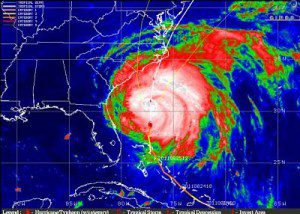As the 2012 hurricane season begins on Friday – with two named storms already in the books – emergency managers have a new way to warn many Americans about looming storms. The ubiquitous cell phone is now a link to evacuation and other emergency information, Federal Emergency Management Agency Director Craig Fugate said Wednesday.
Fugate said that emergency managers will continue to use traditional media, particularly television and radio, to alert people to danger, but plugged the new system now available to most smart phone users that will push geographic-specific cautions to customers in the event of a crisis.
“We’re now able to broadcast to cell phones, that’s been a huge evolution,” Fugate said during a White House briefing Wednesday. “They’ll be able to get information in a push system … we have implemented the technology nationwide to begin pushing information to cell phones.”
Fugate, the former director of emergency management in Florida whose tenure in that job included the monster hurricane seasons of 2004 and 2005, also reminded Americans to make sure they have a cell phone charger, particularly a car charger, as part of their emergency supply kit. While landlines are usually fairly reliable, so many people rely on mobile phones now, Fugate noted, and many people who haven’t been through a hurricane recently may not remember to make sure they have a charger, particularly a car charger so they can charge their phone if the power is out.
The Federal Communications Commission announced earlier this year that the PLAN system, or the Personal Localized Alerting Network, also known as CMAS, or the Commercial Mobile Alert System, now allows emergency officials to send targeted alerts to specific areas through cell towers to users near that tower.
The system could be used for any imminent threat, not just dangerous weather, including terrorist attacks or criminal activity alerts. Because it is based on nearby cell towers, only people in an area in danger would get an alert. For example, a customer in Miami who is visiting Tampa would get alerts about Tampa while there, not about Miami.
Participation by cell phone users is automatic if their carrier participates, meaning they don’t have to do anything to sign up.
The alerts come into the phone and will appear similar to a text message, though the actual technology is different to prevent a slowing of the messages in congested areas. The customer won’t be charged for receiving the messages.
Wireless phone companies were required to enable phones to accept the messages in early April, though their participation in the system is voluntary. The alerts are only those involving imminent threats to safety, alerts issued by the president or Amber Alerts.
FEMA also has a separate service whereby cell phone users can text their zip code to FEMA and get a message back with nearby shelter locations.
by David Royse



